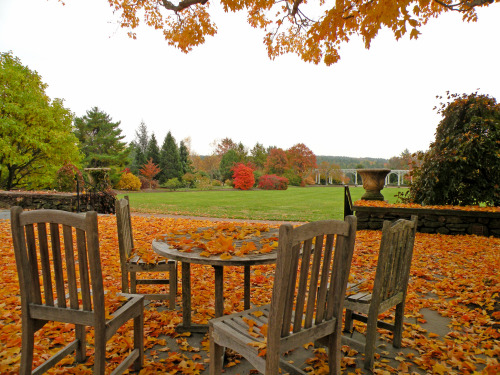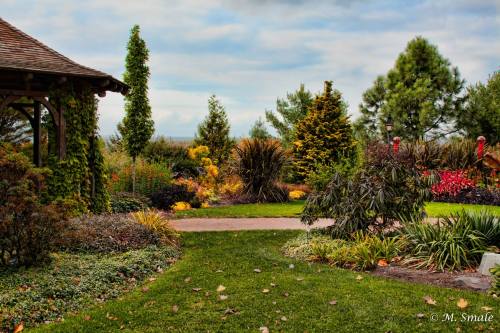
The success of your garden through the winter, and the joy of its emergence in the spring, can be enhanced by a few simple but critical chores undertaken in the fall. Here are three autumn tips from Joann Vieira, New England Botanic Garden at Tower Hill’s director of horticulture, for making sure your landscape is ready to go.
Fall Cleaning! The importance of a thorough fall cleanup is often underestimated, yet vitally important to the control of pests and diseases. All plant material that has shown any signs of insect or disease problems should be removed from the garden and disposed of away from both the garden and working compost heaps. Many insects and diseases overwinter in and around the host plant so removing them from the area is important in breaking the life cycle. Adding diseased material to a working compost heap could reintroduce the problem when the finished compost is returned to the garden, so be sure to dispose of it elsewhere. Cutting back perennials and cleaning up fallen leaves also allows plants to emerge unimpeded in the spring, and frankly makes for a better looking garden through the winter.
There are always exceptions – if you have sturdy perennials that remain interesting during the winter, and provide seeds or nesting materials for birds, you might want to leave them standing to enhance the beauty of your garden in the winter and to support desirable wildlife as well. Coneflowers, ornamental grasses, Siberian iris, Autumn Joy Sedum and Astilbes are classic examples of plants that provide winter beauty. If you have any disease issues with these plants, or high populations of voles and mice, it is best to cut these plants to the ground rather that provide cover and overwintering sites for problems.

Cutting a nice edge on lawns and garden paths adds to the overall beauty of the winter garden and help eliminate one more early spring chore. Rake, chop, or otherwise remove deep layers of fallen leaves from lawns to allow the lawns to luxuriate and not be smothered. Deep layers of leaves also provide good cover for root-feeding voles, removing them exposes voles to predators. Save the healthy leaves from oaks, birch, maples and others to chop up and return to the garden as a fine mulch in spring, or to add to compost heaps. Running over them several times with a lawn mower, especially a mulching mower, creates a wonderful fine mulch.

Director of horticulture Joann Vieira setting tulip bulbs in the Entry Garden at New England Botanic Garden at Tower Hill.
Water, water, water! Many people think the watering season is over as soon as the cool weather sets in but it is critical to water new transplants right up until the ground freezes if Mother Nature fails to deliver weekly supplies of natural rain. In a dry year it might be necessary to water all permanent plantings, not just new transplants, deep into the autumn if the weather patterns do not change. This is especially critical for evergreens who will continue to lose moisture through their leaves throughout the winter.

Apples at New England Botanic Garden at Tower Hill’s heirloom orchard sampled by deer in 2013. (Photo by Dale on Flickr)
Deflect, deter, diminish! If you’ve had problems with deer chewing your prized plants over the winter now is the time to act to reduce the problem this year. Apply liquid taste and odor deer repellents in October when the temperatures are expected to remain above 40 degrees Fahrenheit for a 24 hour period. Granular repellents, scented bars of soaps (wrappers intact), garlic oil dispensers, and fencing can be installed later in the season but should be done before damage is seen. Deer will be out assessing our landscapes now, laying a plan for their winter dining pleasure. Since they follow their noses to our gourmet garden offerings anything we can do to mask the odor or alter the taste of the plants they love will be helpful.
